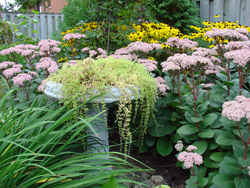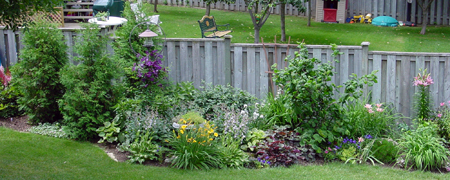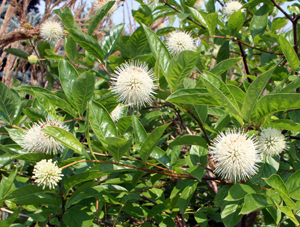I recognize that I am still relatively new to the gardening thing, having only gardened for about 12 years. Yet in that time, my approach to gardening has evolved. Cycles of hot-dry, cold-wet weather teach you a lot about gardening for the long term as do the natural evolution of knowledge that comes with experience and our own changing perceptions of what we deem important. Every garden captures the spirit of the individual who plants and tends their garden — with both garden and gardener aging hand in hand, both benefiting from the experience of the other. From my early gardens to now, my focus and landcape has changed, but the journey has been, and still is, enlightening.
Stage 1 – I never met a plant or trend I didn’t like

A perennial garden is colourful but requires maintenance to look well-tended. Year round colour and avoiding bare spots required more knowledge than I had at the time.
Having been bit by the garden bug, I also succumbed to planting more and more gardens, more than I could handle with my given experience. And, to my young mind, those gardens had to be colourful. Vegetable gardens were ugly and annuals were for my parents, so I only planted flowering perennials. I also didn’t spend enough time preparing the soil, mulching and doing other preventative maintenance. As a result, I quickly become frustrated and overwhelmed.
Stage 2 – The Low Maintenance Deception
After a couple of years of feeling like a dog chasing his tail trying to keep up with the constant cycle of spring cleanup, weeding, deadheading, shearing, more weeding, fall cleanup, repeat, I decided that I needed a better approach. I slowly started to replace many of my more demanding perennials with lower maintenance shrubs.

Our first garden border slowly being converted from all perennials to a mix of shrubs and perennials.
I was still attracted however to everything new and ‘different’. With no overall plan in mind, I purchased shrubs that I liked the look of in the garden center. While I gave some thought to size and shape (having learned a little bit so far), I had yet to learn that the recommendations on the label are all too often inaccurate. It is also wise to learn that sometimes new is not better. It turns out that Japanese Beetles for instance loved my purple corkscrew hazel as much as I did when I saw it in the magazines. I no longer have one.
However, converting over our small garden in town from a largely perennial garden to a mixed perennial-shrub border was a great training ground for our next move – a large 2+ acre property in the country. Our ornamental gardens in our current home are 90% trees and shrubs, with perennials and annuals thrown in very judiciously for colour and texture. This has made managing such large gardens, once they are established, much easier. But let’s not kid ourselves, there is no such thing as a low maintenance garden. Planting a garden is not like arranging furniture and knickknacks in the living room. Shrubs, like children, have a mind of their own and can grow completely differently just 10 feet apart. To be healthy, even shrubs need to be pruned and tended regularly. Weeds need to be dealt with or you will find yourself looking at an overgrown garden in very short order.
Stage 3– Go Native
Moving beyond the basics, I now entered my native plant stage. By now I had the experience to know that plants need to grow in proper conditions – proper soil, climate, water needs etc. I also wanted to be less reliant on fertilizers and chemicals to keep my garden healthy.

Native buttonbush was one of the shrubs that has survived my 'native plant' stage. Not all natives trees and shrubs will work in your garden. Do your homework carefully.
My new approach is to use a mix of both non-native and natives, carefully choosing the right plant for the right location and conditions based on experience and observation where possible. I also plant tried and true favourites. There is a lot to be said for sticking with what works.
Stage 4 – Vegetable Gardening Returns
We dabbled in vegetable gardening throughout our past 12 years growing the basics – tomatoes, cucumbers and beans. But over the past 4 years or so vegetable gardening has become our passion. Our ornamental gardens are now largely established and while I still do small tweaking and add a few new plants here and there, I have no plans to build any new large gardens (like my landscape, I’m getting older and am all too aware that my energy levels are not what they used to be). Tending a vegetable garden also takes time, and teaches you rather quickly that perfection is not achievable. Our vegetable garden is purely organic, no pesticides or chemicals allowed. Learning to carefully monitor for pests and diseases in the vegetable garden, and live with damage that does not ultimately damage the crop itself, has taught me to apply the same approach to our ornamental gardens. I manage bug infestations by hand picking or proactive measures (I love dormant oil). But if a shrub is attacked a little more than it’s neighbour, or weeds grow in the back gardens faster than I can pull them, I no longer worry.My husband doesn’t bother with the ornamental gardens at all – his feeling is if you can’t eat it why bother. As for myself, I have enjoyed feeding my habit for trying new things by adding new varieties and vegetables every year to our repertoire. After all, in vegetable gardening an experiment only lasts one year. If it doesn’t work, oh well, try something else next year. And I can transfer that need for adventure into the kitchen as well — learning new ways to cook with purple potatoes, striped beets and red carrots.
Who knows what the next years will bring — but for now I can enjoy sitting on our back patio with a coffee in the morning and a glass of wine in the evening — enjoying the evolution.

How familiar this all sounds! Been there, except for the vegetables which I still don’t have. But all of the other learning and experimenting and developing is a familiar path many new gardeners must travel. Particularly the long process of acquiring taste and design sophistication! I enjoyed your tale of learning how to garden.
Oh my gosh! I am in heaven browsing thru your photos, advice and tremendous eye for color! You are a garden artist!
I have been learning how to draw a plan using your excellent excel tutorial for garden planning. I would love to interface with you on a new front yard curb appeal project in the Denver Colorado area. Please email me if you would be willing to share some tips for a smaller scale plan